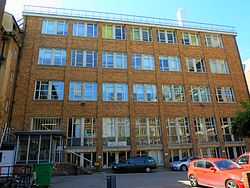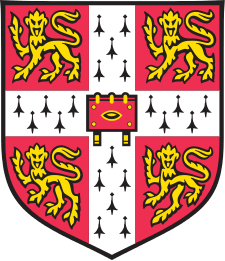Department of Chemical Engineering and Biotechnology, University of Cambridge
| Department of Chemical Engineering and Biotechnology | |
|---|---|
 | |
| Head of Department | Nigel Slater |
| Location |
Cambridge, United Kingdom 52°12′10″N 0°07′13″E / 52.2029°N 0.1202°ECoordinates: 52°12′10″N 0°07′13″E / 52.2029°N 0.1202°E |
| Website |
www |
The Department of Chemical Engineering and Biotechnology at the University of Cambridge is one of the smaller departments in the university. It was formed from the merger of The Department of Chemical Engineering and The Institute of Biotechnology on 1 August 2008. The main site is situated at Pembroke Street, to the south of Cambridge city centre. The department is the primary centre for chemical engineering teaching and research activities in Cambridge, and is currently headed by Professor Nigel Slater (following Professor Lynn Gladden's elevation to Pro Vice-Chancellor for Research).
Research
The department's research areas are biomedical engineering, biosensors, diagnostics, microfluidics, biological engineering, microstructure engineering, measurement techniques, processes and modelling.[1]
Institute of Biotechnology
It was established in 1988 to meet growing demands for highly skilled research personnel, and the new knowledge necessary for continuing expansion of the science platform upon which biotechnology innovations are based. Institute of Biotechnology is separated from the main department's building, and it is currently located at Tennis Court Road.
Institute of Biotechnology's aims are:
1- To conduct research in selected areas of biotechnology. 2- To provide the best training in biotechnology for high quality graduates from the physical, chemical, and biological sciences. 3- To ensure a rapid and effective transfer of ideas and developments in biological science between University and Industry.
Following the Research Assessment Exercise (RAE), the Institute of Biotechnology was awarded grade 5, for the quality of its research.
The Institute of Biotechnology has a multi-disciplinary approach, which fosters and encourages interactive project work between in-house groups. This unique strength gives the Institute important links with those departments containing relevant expertise in the University, with local, national and international Industry, and with research centres around the world.
There are four active research groups within the Institute of Biotechnology. Research activities are holographic sensors, acoustic holograms, biopharmacuticals and spores. The director of the Institute is Christopher R. Lowe, OBE. Other activities include Molecular Biology, Metabolic Engineering, Protein Engineering, Microbiology, Biotransformations, Biodegradation, Plant Biotechnology, Enzyme Technology, Bio-separations, Chemical Sensors, Biosensors, Instrumentation, Combinatorial Chemistry, Molecular Modelling.
Master of Bioscience Enterprise
The Master's in Bioscience Enterprise (MBE) program is a one year multidisciplinary biotechnology and business degree course. It is designed for high-achieving individuals with enthusiasm for enterprise, who have the ambition to found technology businesses or take up leadership, executive or consultancy roles in the life sciences sector.
Buildings
The department is mostly situated in the Shell building on the new museums site, a collection of university buildings and museums in the city centre. The department was formed by a recent merger between the old Department of Chemical Engineering and the former Institute of Biotechnology and will eventually enter a single building on the west Cambridge site. The Magnetic Resonance Research Centre has been situated at the West Cambridge site since it was built in 1997 and houses four Bruker NMR spectrometers in addition to lower field equipment such as Earth's field NMR equipment.[2]
Research Groups
Research in the department is conducted by a number of research groups which act somewhat independently of the department. These research groups are:
- Healthcare Biotechnology Group[3]
- The Combustion Group
- The Magnetic Resonance Research Centre
- The Computational Modelling Group.[4]
- The Laser Analytics Group[5]
